Edward Krasiński's work is a very complex, ephemeral and elusive phenomenon. Its most important aspect is the very life of the artist and his creative attitude towards reality, which is expressed through "life in art". He constantly influenced the world with his personality, irony, humour, undermining and challenging the traditional forms of art and its meanings. From 1940-42, he studied interior design and graphic design at the Kunstgewerbeschule (School of Arts and Crafts) in Kraków, and from 1945-48, he studied painting at the Academy of Fine Arts in Kraków under Władysław Jarocki, Wojciech Weiss, and Józef Mehoffer. During the occupation, he met the artists of the later Second Kraków Group (Tadeusz Kantor, Jerzy Nowosielski and Tadeusz Brzozowski).
In 1954, he moved to Warsaw and from 1966, he collaborated with the Foksal Gallery in Warsaw, which he helped establish with other artists, including Tadeusz Kantor and Henryk Stażewski. From 1970, he lived in the studio of Henry Stażewski with whom he became a lifelong friend. Krasiński is a Lifetime Achievement Award Winner (1998) of the Polish Section of the International Association of Art Critics(AICA) .
The works of Edward Krasiński are in the collections of, among others, Centre Georges Pompidou in Paris, the National Museum in Warsaw, Kraków and Wrocław, the Museum of Art in Łódź, the National Gallery in Prague and Museum of Modern Art in New York.
Drawn Sculptures
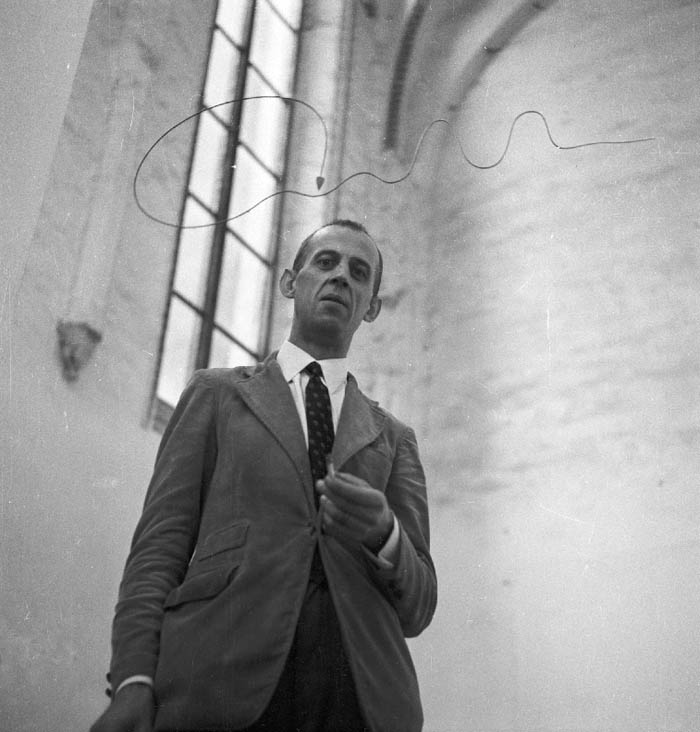 Edward Krasiński, 1965, photo: courtesy of Foksal Gallery Foundation
Edward Krasiński, 1965, photo: courtesy of Foksal Gallery FoundationIn the '50s, Krasiński made erotic drawings, and produced many surrealist paintings (Composition with a Skull, Composition with a Girl and a Line, 1962). He published drawings in the magazine Directions, and designed magazine covers for Poland and You and I. At the beginning of the '60s, he created his first spatial and relief paintings, forms of irregular shapes constructed from wooden boards, hinges, and wire. In 1964, in the open air in Osieki, Krasiński created a spatial painting Spear of the Atomic Age, which he hung in an open space between trees. Julian Przyboś wrote then that 'Krasinski reduced the sculpture to a line'.
Later he created more 'illustration-like sculptures', installations of wires, rods, plastic cables and discs suspended in the air or placed on disproportionately large pedestals. Krasiński was interested in the dynamics of a still object. 'Spears' hanging on wires around trees created an impression of movement.
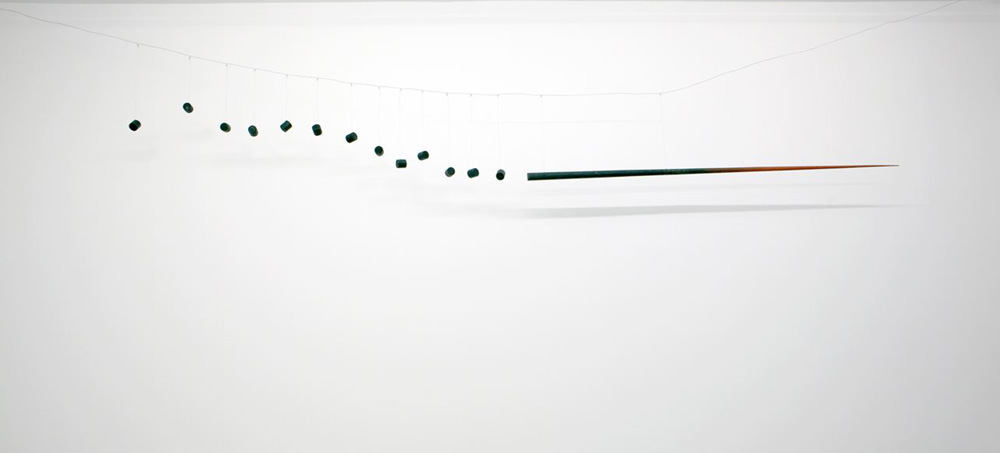 Edward Krasiński, Spear, 1963 -1964, photo: courtesy of Foksal Gallery Foundation
Edward Krasiński, Spear, 1963 -1964, photo: courtesy of Foksal Gallery Foundation
The artist combined banal objects in surprisingly simple constellations which looked like geometric graphs, achieving in his works a formal minimalism - a broken, big wheel, like a piece of a circle, from which hangs a drop of red; ends of cables painted in red; a pipe out of which pops a red ball. The colour condensed at the cable-ends often served as an energy transmitter. The main materials of Krasiński's works from that period were soft and easy to form wires, but made of hard plastic.
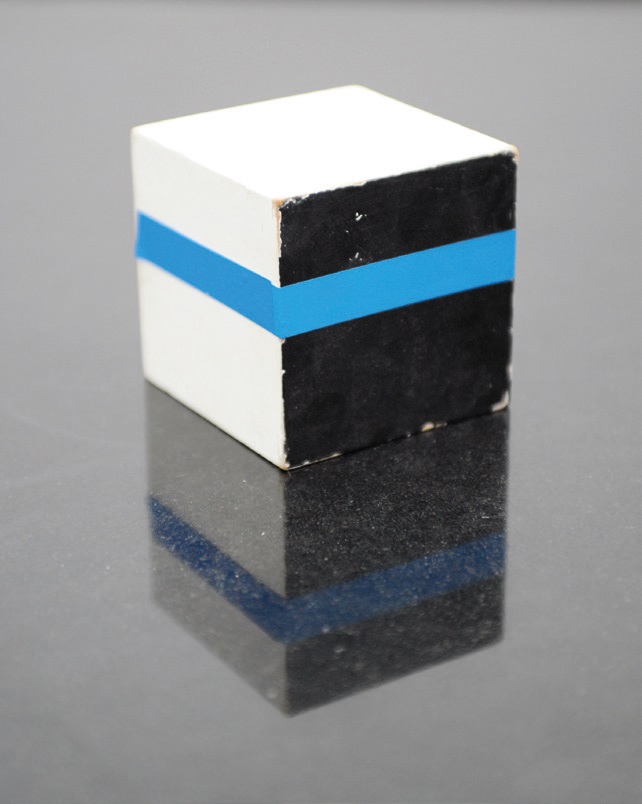 Edward Krasiński, Object, 1960, photo from the collection of Werner Jerke
Edward Krasiński, Object, 1960, photo from the collection of Werner JerkeAt his shows in the '60s, at the Krzysztofory and Foksal Gallery, Krasiński placed these lines in space, built unexpected structures out of them, curled them, and allowed them to live autonomous lives, thus surprising the viewers by their sudden appearance in a completely unexpected place. Around 1968, the artist replaced the hard spools with a soft, plastic cord, and previously used reds, purples and greys with blue. A blue line comes out of one bottle and goes into another (98K1, 1968), bunches of blue wire are leaking from faucets, a machine to grind meat grinds blue cable rolls, a blue bookmark sticks out of a book, the pages of which are glued together (L, 1969). Items entangled in the blue rope have been deprived of their original functions and meanings, and gained new, poetic references. An important aspect of Edward Krasiński's work is his poetics of irony which creates a distance to reality by giving lightness to apparently serious intentions.
Krasiński was involved in the early happenings of Tadeusz Kantor: in 1965 in Cricotage, and in 1967 in a Letter and Panoramic Sea Happening, where, dressed in a tail coat, he conducted the waves facing the horizon while standing on a ladder immersed in water.
 Eustachy Kossakowski, Panoramic Sea Happening, 1967; © Anka Ptaszkowska; photo negative and slide - property of the Museum of Modern Art in Warsaw
Eustachy Kossakowski, Panoramic Sea Happening, 1967; © Anka Ptaszkowska; photo negative and slide - property of the Museum of Modern Art in WarsawBlue Scotch
From 1968, Krasiński marked the space around him with a blue scotch tape sticking it at the height of 130 cm, which became his hallmark. The blue tape appeared for the first time at a reception at his home in the village of Zalesie near Warsaw, where he taped it across two little girls and around some trees.
A line is a coincidence - he later recalled - but I expected that.
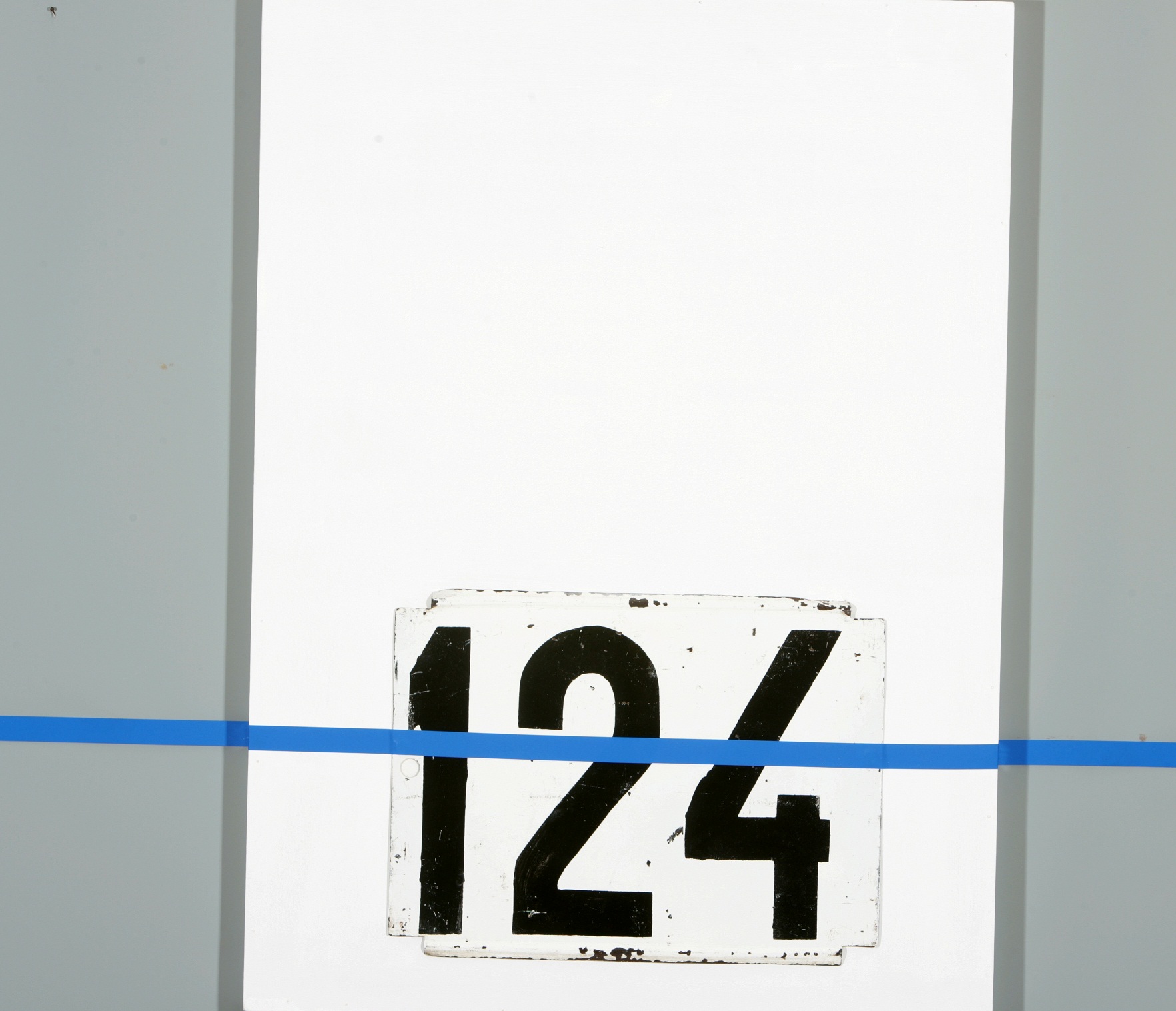 Edward Krasiński, No 124, 1972, photo: courtesy of Art Stations Foundation
Edward Krasiński, No 124, 1972, photo: courtesy of Art Stations FoundationIn 1970, Krasiński participated in the Biennial in Tokyo. When the artworks for his exhibition did not arrive, he sent an 80-metre long telex to the organizers in which he repeated the word BLUE five thousand times. The paper strip was exhibited at the Biennial in place of his works (sculptures with a long, blue winding rubber). A month after the exhibition, Krasiński's sculptures arrived in Tokyo, and then, following the artist's instructions, the strip of paper containing the telex was placed in a bullet-proof glass case and presented as a gift to the museum. Krasiński's blue tape, which the artist used to mark the space around him and define his 'spiritual circle', later appeared regularly. Frequently, the tape was interpreted as a visualization of linear time, and the artist himself saw this as an action similar to Dadaist jokes. Krasiński wrote:
I don't know if this is art. I know that it's a blue Scotch tape, width 19mm, length unknown.
Andrzej Kostołowski wrote:
If one wanted to look for a guiding motif in Krasiński's art, the term infinity seems to be particularly useful. Indeed, the artist wants things impossible: he wants to suggest infinity in a visually perceptible manner.
Into the Maze
 Edward Krasiński, Atelier (puzzles), exhibition at the Foksal Gallery in Warsaw, 1994, photo: Tadeusz Rolke
Edward Krasiński, Atelier (puzzles), exhibition at the Foksal Gallery in Warsaw, 1994, photo: Tadeusz RolkeIn 1970, the artist 'marked his territory' with a blue strip at the Musée d'Art Moderne in Paris and on the gallery windows in the Rive Gauche district. In order to emphasize the blue line on the wall, Krasiński sometimes attached various geometrical structures to it, which resembled flat boxes, opening and closing, the only purpose of which was to make the path of the blue strip more interesting. Later, in its path there were doors without walls and axonometric, illusory images 'in themselves', always in the format 100 x 70 cm, in which the blue strip 'entered', as well as reproductions of famous paintings, that were marked with the blue line. At a retrospective exhibition in 1997, at the Zachęta National Gallery of Art, the blue line 'annexed' the photographic reproduction of The Battle of Grunwald by Jan Matejko. The blue strip could appear anywhere: on the walls of private homes, in coffee shops, toilets, on furniture and drainage pipes.
In the early '80s, Krasiński created several small objects in the form of crosses, alluding to his former 'spears' - works that triggered energy. In the late '80s, he arranged his exhibitions in a maze, where the viewer was guided by the blue line, like Ariadna's thread. The first such maze was created in 1986 in the Foksal Gallery and two years later in Paris at the Donguy Gallery where it was spatially expanded and in the ‘90s at major retrospective exhibitions at the Kunsthalle in Basel and at the Warsaw Zachęta National Gallery of Art.
In his work, Krasiński combined a constructivist tradition with Dadaist humour. However, he disagreed with those critics who attributed conceptualism to his art:
What I do is very real, to disgust. The blue line 'reveals' the wall - God forbid it does not build it nor does it create it, but it reveals it exactly, exposing the reality of the 'unnoticed' wall.
Studio Flat = Avant-Garde Institute
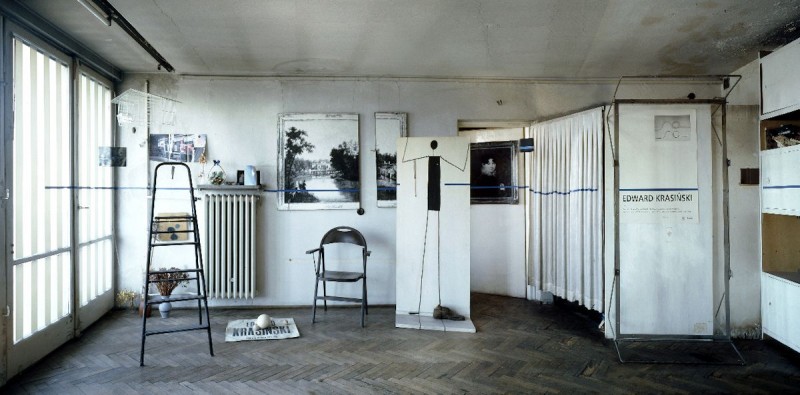 Edward Krasiński's studio flat in Warsaw, photo: Foksal Gallery Foundation in Warsaw
Edward Krasiński's studio flat in Warsaw, photo: Foksal Gallery Foundation in WarsawA very important place for Krasiński was his studio in Warsaw located at Solidarność Ave. (former Świerczewski Ave.). From 1970, he shared it with Henryk Stażewski, and after Stażewski's death, in 1988, Krasiński lived there alone until he himself passed away in 2004. The studio was his artistic environment where he worked and invited Polish and foreign artists to join him. At an exhibition held in 1989, a year after Stażewski's death, Krasiński 'moved' his entire studio, in the form of photographs, to Foksal Gallery. In the '90s, he presented further 'photographic reinterpretation' of his immediate surroundings, such as the studio, the apartment or the Foksal Gallery, which then found their way into museums (such as for shows in Munster, Leipzig, Berlin, Warsaw).
In 2004 the Foksal Gallery Foundation founded the Avant-Garde Institute in the apartment/studio on the eleventh floor of the apartment block at Aleja Solidarności 64 in Warsaw. One year later Maurizio Cattelan donated his Arnold Bode Prize on the behalf of the studio renovation. The plan of expanding the spot (e.g. by a two-floor terrace) was realised thanks to Paulina Krasińska’s and Mondrian Foundation’s donations. The Avant-Garde Institute web page informs:
Its main purpose is to preserve Edward Krasiński’s studio and make it available to the public. In the apartment/studio that Krasiński inherited from Henryk Stażewski, a pioneer of avant-garde art in Poland, has been preserved a unique collection of works arranged by the artist in the years 1988–2002. The installation remains unchanged since Krasiński’s death in 2004. Its main feature is blue Scotch tape, stuck by Krasiński horizontally at the height of 130 centimetres, ‘everywhere and on everything’.
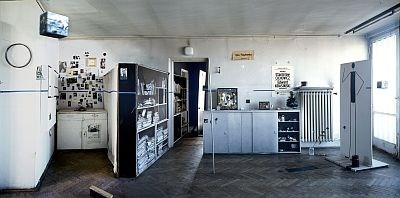 Edward Krasiński's studio, Warsaw, photo: Aneta Grzeszykowska & Jan Smaga / courtesy of Foksal Gallery Foundation
Edward Krasiński's studio, Warsaw, photo: Aneta Grzeszykowska & Jan Smaga / courtesy of Foksal Gallery FoundationThe newly created terrace with a glass pavilion is used for exhibitions, educational workshops and readings. Those events are meant to build up the context for the tradition created by Stażewski and Krasiński. The organizers comment:
The confrontation of Krasiński’s ephemeral works with new exhibitions and critical reflection makes the Avant-Garde Institute a unique experiment in contemporary museum practice.
Selected Solo Exhibitions:
- 1965 - Edward Krasiński, Krzysztofory Gallery, Kraków, Poland
- 1968 - Edward Krasiński, Foksal Gallery, Warsaw, Poland
- 1974 - Edward Krasiński, Repassage Gallery, Warsaw, Poland
- 1975 - Edward Krasiński, Gallery 28, Paris, France
- 1980 - Urban action near 'Gruba Kaśka' restaurant, Warsaw, Poland
- 1982 - Edward Krasiński, Gallery 72, Chełm Lubelski, Poland
- 1985, 1986, 1987 - Edward Krasiński, Foksal Gallery, Warsaw, Poland
- 1988 - Edward Krasiński, Donguy Gallery, Paris, France
- 1989 - Edward Krasiński. In the memory of Henryk Stażewski, Foksal Gallery, Warsaw, Poland
- 1991 - Edward Krasiński, Museum of Art, Łódź, Poland
- 1993 - Around the person and works of Edward Krasiński, Public Library, Legionowo, Poland
- 1994 - My daughter's home and me, The Old Gallery, Lublin, Poland
- 1995 - Edward Krasiński. Finally in Łucku, Lubart Castle, Łuck, Ukraine
- 1996 - Edward Krasiński, Kunsthalle Basel, Basilea, Switzerland
- 1997 - Edward Krasiński, Zachęta National Gallery of Art, Warsaw, Poland
- 1998 - Edward Krasiński, Arsenał Gallery, Białystok, Poland
- 2001 - Edward Krasiński, Klosterfelde Gallery, Berlin, Germany
- 2003 - Edward Krasiński, Anton Kern Gallery, New York, USA
- 2006 - Edward Krasiński. Les mises en scene, Generali Foundation, Vienna, Austria
- 2003 - Edward Krasiński, Anton Kern Gallery, New York
- 2004 - Infinity of the Line. Hommage à Edward Krasiński, Muzeum Sztuki in Łódź, Łódź
- 2004 - Edward Krasiński, Anton Kern Gallery, New York
- 2006 - Edward Krasiński. Les mises en scène, Generali Foundation, Vienna
- 2008 - ABC, The Bunkier Sztuki Gallery of Contemporary Art, Kraków
- 2013 - B, Fundacja Galerii Foksal, Warsaw
- 2013 - Labyrinth, Starmach Galery, Kraków
- 2016-2017 - Edward Krasiński, Tate Gallery, Liverpool
Selected Group Exhibitions:
- 1962 - Arguments 1962, The Crooked Circle Gallery, Warsaw, Poland
- 1965 - Confrontations 65, El Gallery, Elbląg, Poland
- 1965 - First Biennial of Spatial Forms, Elbląg, Poland
- 1967 - 5th International Exhibition, Guggenheim Museum, New York, New York, USA
- 1970 - 10. Biennial, Tokyo, Japan
- 1970 - Musee d'Art Moderne de la Ville de Paris, Paris, France
- 1972 - Atelier 72, The Edinburgh Festival, Richard Demarco Gallery, Edinburgh, Scotland
- 1978 - 43. Biennale of Modern Art, Venice, Italy
- 1978 - Polish Sculpture, Musee d'Art Moderne de la Ville de Paris, Paris, France
- 1979 - Polish Avant-Garde 1919-1978, Palazzo delle Esposizioni, Rome, Italy
- 1985 - Dialogue, Moderna Museet, Stockholm, Sweden
- 1986 - Komoji-Krasiński-Stażewski, Foksal Gallery, Warsaw, Poland
- 1991 - A collection of twentieth-century art at the Museum of Art in Lodz, Zachęta National Gallery of Art, Warsaw, Poland
- 1994 - Europe, Europe. The Century of the Avant-Garde in Central and Eastern Europe, Bonn, Germany
- 1997 - Express Polonia. Polish Art 1945-1996, Mucsarnok, Szepmuveszeti Muzeum, Kortas Muveszeti Muzeum, Ludwig Muzeum, Budapest, Hungary
- 1999 - A Creeping Revolution, Foksal Gallery, Warsaw, Poland
- 2000 - Amateur/Eldsjal, Goteborgs Kunstmuseum, Goteborg, Sweden
- 2000 - Manifesta3, Ljubljana, Slovenia
- 2003 - Form Specific, Moderna Galerija Ljubljana, Ljubljana, Slovenia
- 2004 - PRYM, BWA, Zielona Góra
- 2004 - Krasiński – Kamoji. The Blue Tape and Shadow, Foksal Gallery, Warsaw
- 2004 - Hommage à Edward Krasiński, Muzeum Sztuki in Łódź
- 2004 - Collected Views from East or West, Generali Foundation, Vienna
- 2006 - Implosion (Ten Year Anniversary), Anton Kern Gallery, New York
- 2006 – The Exotic Journey Ends, Foksal Gallery Foundation, Warsaw
- 2006 - Living Art - ON THE EDGE OF EUROPE, Kröler-Müller Museum, Otterlo
- 2007 - Classics and Virgins. From the Collection of Starmach Gallery, National Museum in Wrocław
- 2009 – Collection: Twenty Years of the Starmach Gallery, National Museum in Kraków
- 2010 - Les Promesses du pass. Une histoire discontinue de l’art dans l’ex-Europe de l’Est, Centre Pompidou, Paris
- 2010-2011 - On Line: Drawing Through the Twentieth Century, MoMA, New York
- 2011 - Blue Scotch, Starmach Gallery, Kraków
- 2011 - Ostalgia, New Museum in New York
- 2011 - On Line. Drawing Through the Twentieth Century, Museum of Modern Art in New York
- 2012-2013 - A Bigger Splash: Painting after Performance, Tate Modern Gallery in London
- 2013 – An Approach to Being: Darkness, Infinity, Everyday Life, Kyoto City University of Arts, Kyoto
- 2014 – The 31st International São Paulo Biennale of Contemporary Art
- 2014 – Ideally Balanced, Organically Abstract. The Polish Avant-Garde in Düsseldorf, Düsseldorf Quadrennial 2014, Polish Institute in Düsseldorf
- 2015 - Edward Krasiński – Solidarity Avenue / Aleja Solidarności, Flat Time House, London
Author: Ewa Gorządek, Centre for Contemporary Art Ujazdowski Castle in Warsaw, May 2006, updated: AW, March 2016